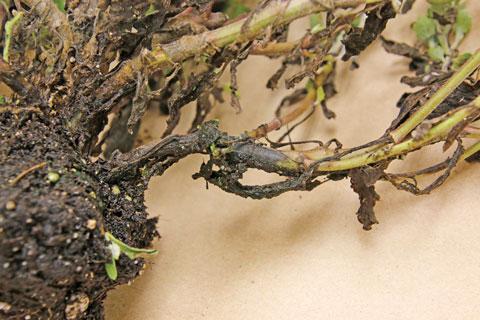2/1/2023
Did We Need Another Mum Disease?
Margery Daughtrey, Nora Catlin & Francesca Hand
 Previously published in the October 2022 edition of the
Previously published in the October 2022 edition of the e-Gro Alert
newsletter.
Pictured: Discolored stem tissue is one of the symptoms of P. chrysanthemi infection.
If you asked any mum grower, they would tell you that chrysanthemums already had plenty of diseases and didn’t need another one. But it seems that the flower industry didn’t get to make the call on this one.
We have been aware of a new threat to mums for five years since an Ohio report described a Phytophthora disease from several cultivars in a large landscape planting. The pathogen was not one of the Phytophthoras that we are more familiar with, e.g., Phytophthora nicotianae or P. cactorum. Instead, researchers in Ohio worked from root and stem rot symptoms to isolate a Phytophthora species not previously known to occur in the United States, named Phytophthora chrysanthemi.
This pathogen appears to be favored by high temperature conditions (86F/30C and above) based on its laboratory behavior and the summer timing of the first documented outbreak in the United States. Infection is associated with stunting, purpling and death of foliage on one major branch or the whole plant. Root rot is also apparent.
Immunostrip tests (Agdia, Inc.) and likely other serological tests for Phytophthora can be used on discolored stem tissue to get an initial indication that this pathogen may be responsible for symptoms in production or the landscape. In order to confirm the pathogen, diagnostic labs will find it helpful to culture at 82 to 86F (28 to 30C), which is warmer than standard practice.
 Pictured: Healthy mum plant (left) compared to a mum plant infected with P. chrysanthemi (right).
Pictured: Healthy mum plant (left) compared to a mum plant infected with P. chrysanthemi (right).
Recently, similar symptoms were observed in a 2022 garden mum crop in New York. Various hypotheses were considered, including feeding by the European pepper moth (Duponchelia fovealis), Fusarium wilt, Rhizoctonia stem canker and Pythium root rot—all of which are commonly found on mums. However, Immunostrip tests were positive for Phytophthora, indicating that the newly discovered P. chrysanthemi might be the culprit. Isolations are underway.
Disease caused by P. chrysanthemi may be challenging to identify because this pathogen is difficult to isolate and so many other agents can reduce the water supply to the top of the plant and also cause discoloration, wilting and death. Stay alert to the possibility of this new Phytophthora disease—do not assume that you know why your mums are wilting.
Trials have not been conducted for management of this specific disease, but one would expect that fungicides effective against other Phytophthora diseases would protect against it when used preventively with appropriate rotation. Effective fungicides include materials with the active ingredients cyazofamid, dimethomorph, etridiazole, mandipropamid, mefenoxam, oxathiapiprolin and strobilurins. Watch for symptoms of root rot or wilt in cuttings during propagation and identify their cause so that problems don’t surprise you during the finishing stages of the mum crop. GT
Margery Daughtrey is a Senior Extension Associate for Cornell University Section of Plant Pathology and Plant-Microbe Biology at the Long Island Horticultural Research & Extension Center. Nora Catlin is a Floriculture Specialist at the Cornell Cooperative Extension in Suffolk County. Francesca Hand is Associate Professor in the Ornamental Crops Pathology Program at The Ohio State University.